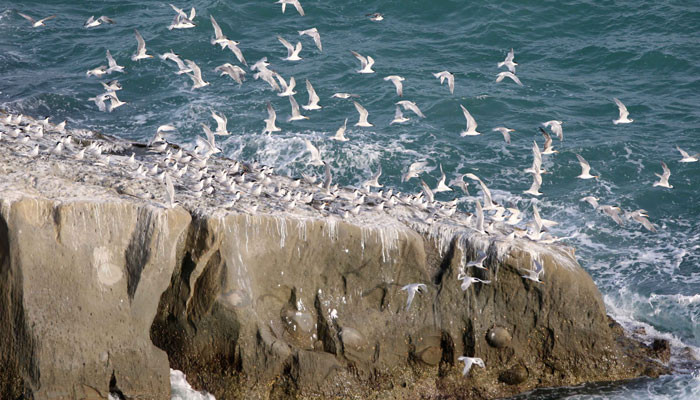Astola Island Receives Management Plan Approval After Eight Years
Nearly eight years after its designation as Pakistan’s first marine protected area (MPA) in June 2017, Astola Island, also locally known as Jezira Haft Talar, has secured an officially endorsed management strategy from the Balochistan government, called the Astola Island Marine Protected Area (AIMPA).
Pakistan is a signatory to the United Nations Convention on Biological Diversity. During the 1992 Rio Earth Summit, 150 nations committed to the CBD, promoting the preservation of global biodiversity and the sustainable utilization of resources.
As part of the convention, numerous countries developed initial Biodiversity Action Plans, with Pakistan creating its plan in 1999, targeting completion by 2010.
However, the CBD’s Global Biodiversity Outlook 3 (GBO3) reported that the 2010 goals were not globally achieved. Consequently, at the 10th Conference of the Parties (COP) to the CBD in 2010, held in Aichi Prefecture, Japan, the Strategic Plan for Biodiversity 2011-2020 was adopted, outlining the Aichi Biodiversity Targets (ABTs) with five strategic goals, each encompassing 20 sub-targets, aimed for completion by 2020.
The COP15 to the CBD in 2022 established the Kunming-Montreal Global Biodiversity Framework (KMGBF), envisioning a world living in harmony with nature. It states that by 2050, biodiversity should be valued, preserved, restored, and sustainably used, maintaining ecosystem services, sustaining a healthy planet, and ensuring benefits for everyone. The framework sets four overarching goals for 2050 and 23 actionable global targets for 2030.
Within the KMGBF, Target 3, named Conserve Land, Water and Seas, aims to protect and manage at least 30% of terrestrial, inland water, marine, and coastal regions, particularly those crucial for biodiversity and ecosystem services, by 2030.
As a signatory, Pakistan must meet this target. The Federal Ministry of Climate Change and Environmental Protection oversees Pakistan’s international climate change and environmental commitments, while provincial governments manage domestic protected areas.
By declaring MPAs and implementing management strategies, Pakistan significantly contributes to the 2030 global target. Several potential MPA sites have been identified in Balochistan and Sindh. Astola Island MPA was the first designated MPA in Pakistan on June 15, 2017.
According to the management plan, Astola Island contains diverse terrestrial, intertidal, and marine habitats and biodiversity, holding national and international significance. The report notes that although Pakistan lacks coral reefs, Astola shows early reef formation with 11 identified hard coral species in a 2018 survey, including five vulnerable or near-threatened species.
The report also indicates that Astola Island features vital nesting sites for green turtles, classified as endangered by the International Union for Conservation of Nature (IUCN). Astola Island is the exclusive habitat of the saw-scaled viper. Additionally, the first sightings of sea anemones and Gardiner’s butterflyfish in Pakistan occurred around Astola Island.
The AIMPA strictly prohibits activities such as harming endangered marine species, using explosives or chemicals for fishing, constructing unauthorized structures, unauthorized stays, and using firearms, except by law enforcement. Recreational activities like scuba diving, jet skiing, and sport fishing require prior authorization and must align with CBD guidelines to ensure minimal ecosystem disruption.
According to an IUCN Pakistan press statement, the Balochistan government officially approved the Astola Island management plan following months of interventions and consultations.
The Federal Ministry for Climate Change established the National Coordinating Body (NCB) to facilitate the KMGBF 30×30 targets, resulting in Astola Island’s MPA designation. The NCB identified management gaps and tasked IUCN Pakistan with developing a comprehensive management plan.
The 3rd Subcommittee Meeting on MPAs, convened by IUCN during the 24th NCB Meeting, advanced AIMPA implementation. An IUCN press release stated that this directly supports Pakistan’s commitments under the CBD 30×30 target, the ABT, and the KMGBF.
The IUCN categorizes protected areas, including MPAs, into six types based on management objectives. Astola Island MPA is a Category IV site focused on habitat or species management, prioritizing their protection. This may involve regular interventions to meet the needs of specific species or habitats, which is expected to be crucial for Astola Island MPA.
Aisha Humera Chaudhary, Federal Secretary, Ministry of Climate Change & Environmental Coordination (MoCC&EC), noted that the NCB has been vital for advancing Pakistan’s marine conservation efforts and that the Astola Island Management Plan endorsement marks a national achievement.
Abdul Fattah Bhangar, Secretary, Forest & Wildlife Department, Government of Balochistan, affirmed the Balochistan government’s commitment to implementing the MPA, ensuring its success with support from partners and in line with global biodiversity frameworks. He acknowledged IUCN’s technical leadership and collaborative efforts.
Mahmood Akhtar Cheema, Country Representative IUCN Pakistan, emphasized the need to transition from planning to action due to increasing pressures on Pakistan’s marine resources from climate change and human activities. He stressed sustained engagement through the NCB platform to protect Astola Island and support broader marine conservation. He also acknowledged the Ministry of Defence, including the Pakistan Navy’s support.
Favad Soomro, head of Engro Foundation, highlighted the private sector’s role in conservation and climate resilience, reiterating the importance of cross-sector collaborations for environmental outcomes and the contributions of the NCB forum. He also noted the increasing recognition of cultural and heritage sites in conservation planning.
Chief Conservator Forests Sindh Riaz Ahmed Wagan informed attendees about the feasibility study for Patiani and Dabbo Creeks as potential MPAs, discussing their ecological significance and assessment methodology, which reinforces their potential MPA designation.
Najab Uddin Sehto and Abdul Fattah Bhangar, secretaries of the Forest & Wildlife Departments of Sindh and Balochistan, respectively, acknowledged the growing momentum of marine conservation in Pakistan and appreciated the commitment of organizations like IUCN to protecting the country’s marine ecosystems.



Comments (0)
No comments yet. Be the first to comment!
Leave a Comment